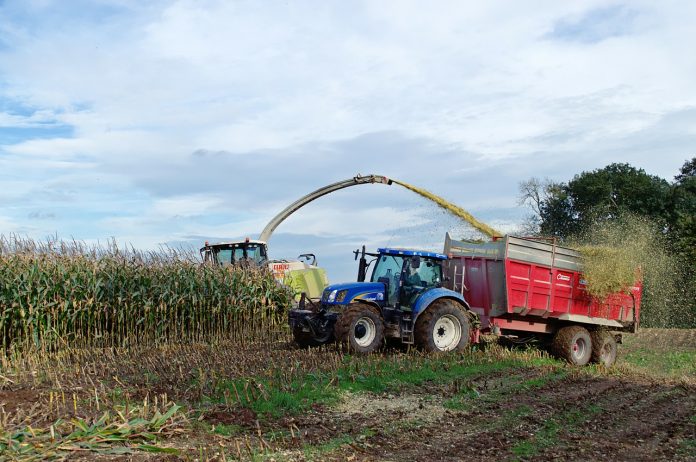More comfortable temperatures and corn silage harvest are sure signs of fall. The cooler temperatures are good for the cows and those working to feed and care for them. According to the 2020 USDA NASS Report, there were 200,000 acres of corn silage harvested in Ohio, averaging 21 tons per acre.
Early reports from across Ohio indicate very good yields so far this year. Harvesting operations can be dangerous. Please take a few minutes to review safety precautions and harvest recommendations.
Silos and fires
Silos can contain deadly gases. These gases, nitrogen dioxide and carbon dioxide, are a natural result of ensiling. Nitrogen dioxide is heavier than air and may be seen as a reddish to yellowish-brown haze. Since it is heavier than air, it can be found near the base of a recently filled silo.
It has a bleach-like smell, and you will experience a burning sensation in your nose, throat and chest. Instant death may result from nitrogen dioxide inhalation.
Carbon dioxide fills the headspace of the silo, replacing the air. Exposure to these two gases happens most often in the first three weeks after the silo is filled. Tower silos and areas around stored silage should be treated as confined spaces. Due to this risk of exposure, it is suggested that you stay out of the silo for the first three weeks, unless wearing a self-contained breathing apparatus.
Besides holding deadly gases, silos can also become the sites of fires and explosions. Silo fires often result from ensiling feeds too low in moisture, usually below 45% moisture.
The heating of the materials in combination with air leaks in the silo structure can allow a fire to start anywhere within the structure and to continue burning for long periods of time. Once a fire starts, it is very difficult to control or stop.
Rollover safety
Tractor rollover is a concern when packing silage piles and bunkers. According to the National Ag Safety Database, tractor overturns account for an average of 130 deaths per year in the U.S., 80% of overturns are by experienced operators and one in 10 operators will overturn a tractor in their lifetime.
A properly sized tractor must be equipped with a Rollover Protective Structure and a seat belt. Rollover protective structures became available in the mid-1960s.
These structures were not available for all new tractors until the mid-1970s. They were not standard equipment on new tractors until 1985. But these structures and seat belts are 99.9% effective in preventing deaths due to tractor overturns.
Harvest reminders
Dr. Bill Weiss, emeritus extension specialist in dairy nutrition, provides several reminders for harvesting corn silage. Corn plants should be chopped when they reach the correct dry matter concentration. The ideal dry matter for corn silage is between about 30% (for bunkers) and 38% (uprights).
The least digestible part of the corn plant is the stalk. It has high concentrations of neutral detergent fiber and lignin. When cutting height is increased, more stalk is left in the field, which reduces the proportion of corn silage that is stalk and increases the proportion that is leaves and ears.
Typical stubble height for corn is 4 to 6 inches, and most of the research on high cut corn had stubble heights of 15 to 18 inches.
Ideal chop length for corn silage is a compromise between what is good for silage fermentation, and what is good for the cow. Historically, chop length has been described as the theoretical length of cut at which the chopper was set, but this is a poor descriptor of actual particle size of the silage.
A better approach is to measure particle size at the time of chopping with a device such as the Penn State Particle Separator. Corn silage that had not been kernel processed with 3-6% of the silage on the top screen and 60-65% on the second screen of the Penn State Separator was equal or better than more coarse silage based on chewing time, rumen pH, milk fat percentage and starch digestibility.
For processed corn silage, a very wide range in particle sizes (equivalent to approximately 2-21% on the top screen) had no effect on chewing time, rumen pH, milk fat, sorting, intake or digestibility. Particle size evaluation should be done when you start chopping so that adjustments can be made.
The main advantages to proper kernel processing are that corn silage can be chopped coarser without decreasing digestibility of the kernel (starch) and it makes particles more homogenous (makes sorting more difficult). Proper kernel processing is when most of the kernels are physically damaged.
Silage making is an important job that provides necessary feed for dairy animals across Ohio. When making silage, monitor corn progress, aim to harvest at the proper moisture to ensure high quality and follow all safety precautions.













